Red Sea: Passage Report on a Successful Trip from SV Joana
A successful passage through the Red Sea requires preparation, according to Wade Alarie, moderator of the Red Sea Passage Facebook Page who sailed the route from Cochin, India arriving in Eastern Turkey in June 2020.
Published 5 years ago
From my perspective, the best season for making a passage though the Red Sea (either Northbound or Southbound) is from December to May. There are some cruisers who attempt to do this route outside of that timeframe, but those that do may encounter uncomfortably high temperatures and extremely strong winds. From my experience, although everyone knows about the pirate risk – there is far greater risk from lack of preparation.

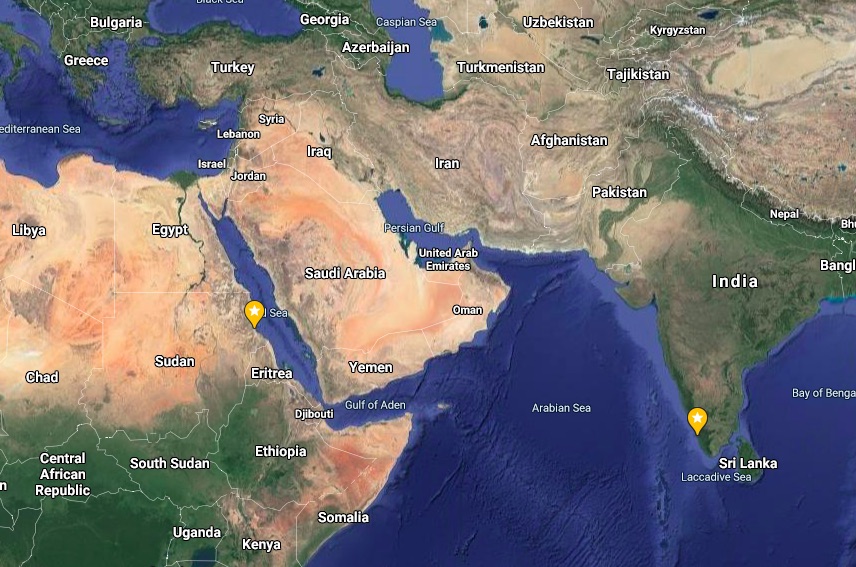
- SV Joana made a successful passage from Cochin, India to Turkey through the Red Sea and Suez Canal.
Preparation is vital
Like any ocean passage and foreign coastline, this route requires extensive boat mechanical preparation (bring all conceivable spares with you, because repair facilities are rare), good charts and lots of food, water and diesel. Good communications are essential, and I found WINLINK connectivity to be difficult therefore relying entirely on my IridiumGo device.
There is an obvious need to coordinate your passage with UKMTO and MSHOA, and they in turn will keep the Multi-National Coalition Forces appraised of your whereabouts. In my opinion, pirate activity is well under control, as long as you keep your AIS on, display nighttime navigation lights and talk with commercial ships and the multitude of Coalition Forces in the area.
Areas to avoid
The coastal waters of Yemen should be entirely avoided. One yacht had a skiff race by obviously under remote control during an attempted act of terrorism on a Saudi oil tanker. These acts are not directed at cruisers, but you may end up suffering collateral damage if you stray too close to Yemen. Do not pass between Socatra and mainland Somalia.
We chose to break up our passage from Thailand to the Med in two seasons, passing from Phuket to Cochin India in the February-March 2019 timeframe, and then the second season from Cochin to the Med in the January-June 2020 timeframe.
Cochin, India to Suez
Just from Cochin to Suez, we consumed 1500L of diesel (32T, 53 foot sailboat). We carried 850L in tanks, and 300L on deck in jerry cans. We bought fuel in Djibouti, Suakin Sudan, Port Ghalib and Port Suez Egypt. We suffered some fuel line blockage near Djibouti and had to clean lines and one tank in Djibouti (requiring the rental of a fuel pump, lots of rags, and many empty jerry cans) on anchor.
Although we sailed a lot, entirely downwind from Cochin to Djibouti – on the leg from Massawa to Suez, you are forced to wait for days, sometimes weeks, not just for favourable winds – but for low North winds (we motored against 15 knots at times). For the first leg from Cochin to Djibouti, we were mostly on a dead downwind run, with the jib and mainsail wing-on-wing.

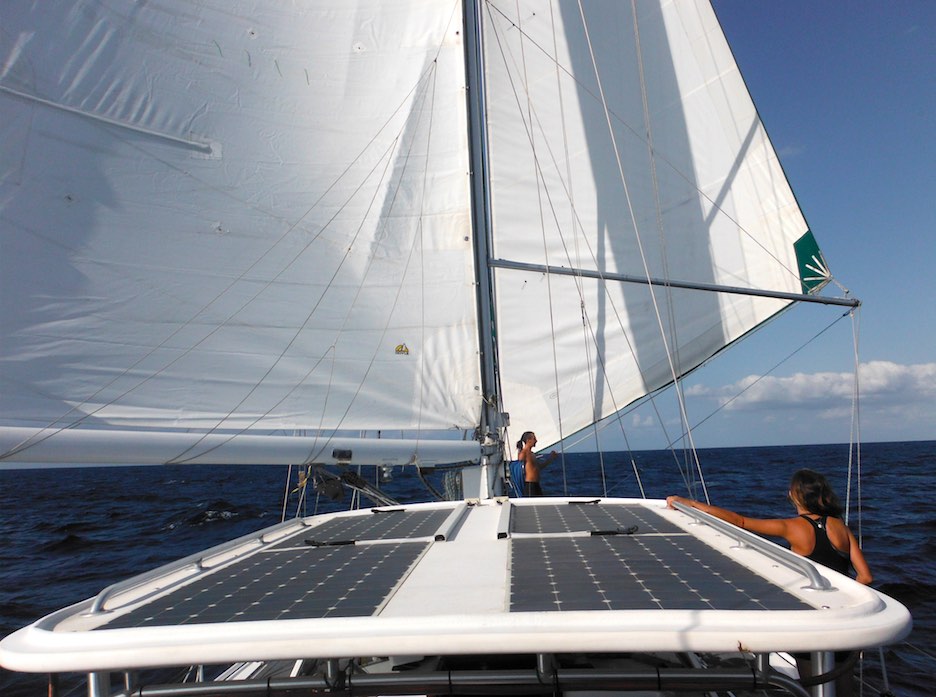
- SV Joana sailing wing on wing through the Red Sea.
Passage numbers
According to records kept by Capt Heebie (Prince of the Red Sea – an agent for the Suez Canal), there were 53 yachts that completed this passage this season (December 2019 to June 2020). Most of these were Northbound, but there were several Southbound. The Southbound boats benefit from consistent North winds at the Northern section, but then are challenged as they close in on Djibouti and try to go East or South.
My own records show 40 boats, but the difference lies mainly in the number of cruisers that do not belong to the Red Sea Facebook Group. Perhaps 1/3 of the cruisers following this route either chose not to belong, or were unaware of the group. These numbers are definitely lower than last year, and I suspect the reason is that many cruisers postponed departure, or became stuck in Maldives, India, Sri Lanka, Malaysia and Thailand because of COVID-19 — and simply made the right choice to delay their passage until next year. At this time, there are are probably 10 boats “stuck” in Djibouti, Port Ghalib, Port Hurghada and Jordan. They chose to berth their boat and fly home.
Check-in to Eritrea
We checked in to Eritrea, and despite the lack of Internet, found the people to be very friendly and hospitable. We would not hesitate to go there again.

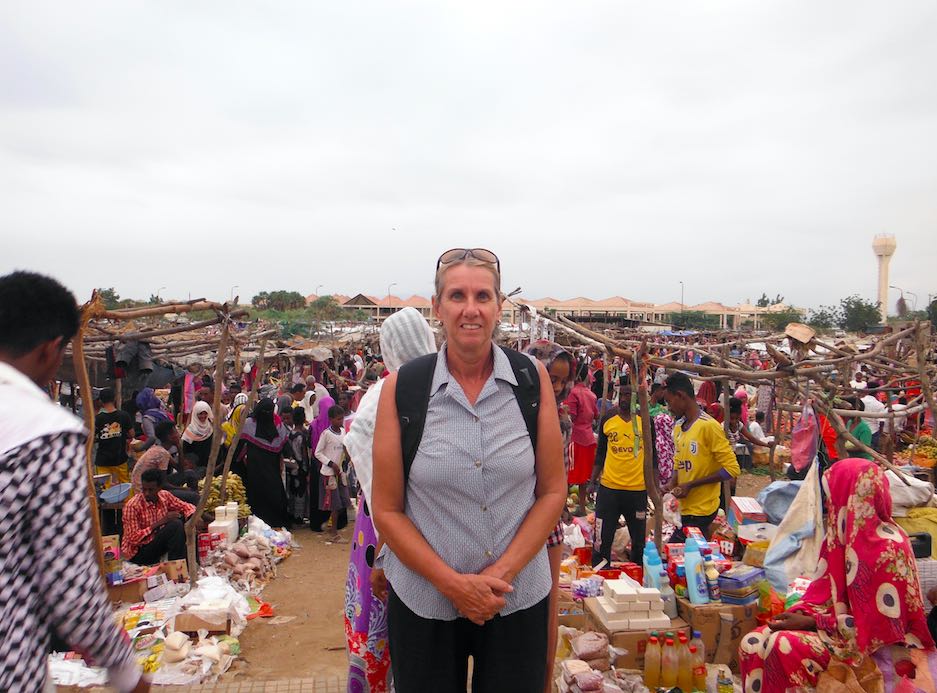
- Diane at the Friday Market in Eritrea.
There are mishaps
In November 2019, one yacht ran aground on the shore of Egypt mid-way between Port Ghalib and Port Hurghada. This was a single-hander, and was either a navigation error, or some kind of personal misfortune. The Captain was never found, and the yacht remains on the shoreline, ready to be pulled off. The sails were not up, and it appears that the boat simply stayed on course and ran up on shore with the engine running.
In January 2020, another boat hit a reef and was lost near Suakin Sudan. In this case, the boat had had numerous previous persistent problems with fuel and engine reliability, and this incident was likely a navigational error. There was no loss of life.
Navigation charts
I found that the commonly used OpenCPN CM93 charts were poor near mainland, but good in offshore/international waters. I also found that our iPad Navionics charts looked good, but were actually incredibly bad – a complete work of fiction. Again, they seemed OK in deep water but were not trustworthy near shore or reefs. For this passage, all cruisers are strongly recommended to augment their existing chart inventory with satellite images, daytime reef entry and eyeball navigation. James Cole made an incredibly detailed set of Google Earth KAP files (100GB +) that have been passed around through the South-East Asia cruising community.
There is also a copy held with the Marina Manager at Cochin India. These KAP files are indispensable with OpenCPN. I also used an iPad and the free app called Ovitalmap. This app allows you to browse many areas in advance of your passage, and you can revisit them weeks or even months later. The data is held in the cache and is not reliant on an Internet connection.
Lots of fish
During most of the passages, we caught a lot of fish, primarily at dawn and at dusk, just by trailing a line or two with a colourful squid lure. We caught mahi-mahi, lots of tuna, and barracuda (in the north part of the Red Sea). We released the barracuda.

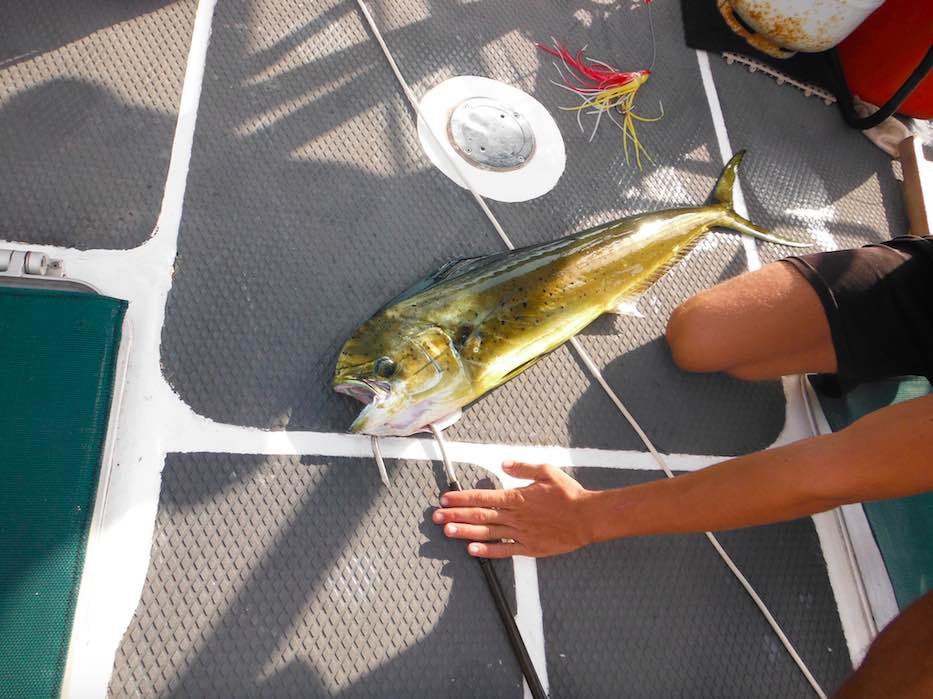
- Red Sea Mahi Mahi.
Piracy, security and COVID-19
To the best of my knowledge, there was not a single incident of piracy or thievery, although since the pandemic COVID-19 struck in the March-June 2020 timeframe, there were not unexpected examples of opportunistic thievery in Djibouti, Sudan and of course – Egypt.
There were some cases of people being charged very high “agent” and commodity prices – simply because you had no options, the borders were closed. Based on fear and xenophobia, many boats were ordered to leave anchorages, a common tactic applied in many other areas of the world.
Unfortunately, there were at least 20 yachts that became caught up in this, moving from Djibouti to Egypt, and with no ports that would take them. They continued moving slowly to the Suez Canal (which remained open) and then waited for an extended period of time mid-way, at Ismailia – until some Med ports finally opened.
On the other hand, I am aware of many yachts being assisted by the Egyptian, Saudi Arabian, and French Navies – with food, fuel and water. Also, although many yachts were “turned away” there was also emergency resupply going on in Djibouti, Port Sudan, Port Ghalib and Port Suez.
There has been a confusing report of a Turkish catamaran that was detained by government forces in Eritrea while trying to enter the port at Massawa. I’m uncomfortable with providing any details, primarily because the boat is now in Djibouti and the Captain has not yet provided a first hand account of what happened. It is known that the boat and crew were detained, for several weeks, and not afforded the opportunity to contact their families. People who have been to Eritrea know that Internet is not available, and communications outside the country is next to impossible. Nonetheless, this serves as another example of the difficulty that at least one yacht encountered while passing through this area during a world-wide pandemic.
Suez canal traffic
There was a considerable amount of shipping traffic getting close to and inside the Suez Canal, but in my experience it was much less than in the Singapore Straits.

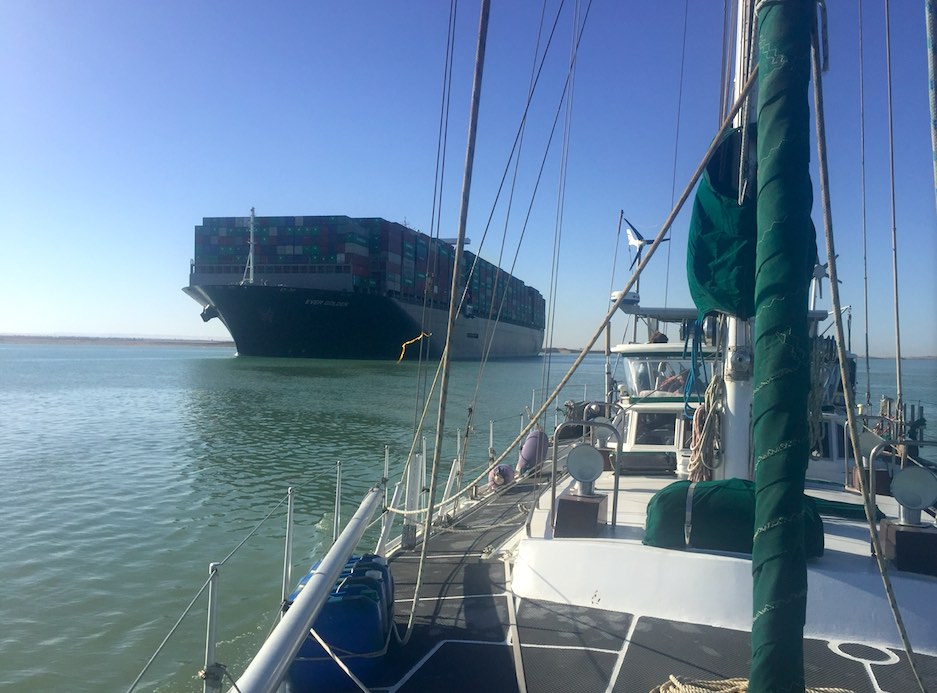
- Up close and personal with a container ship in the Suez Canal.
Our agent at Port Suez was Capt Heebie (Prince of the Red Sea). He treated us very well, and was very attentive to our needs, providing us with diesel, water and a shopping list of fresh fruit and vegetables. I can highly recommend Capt Heebie.

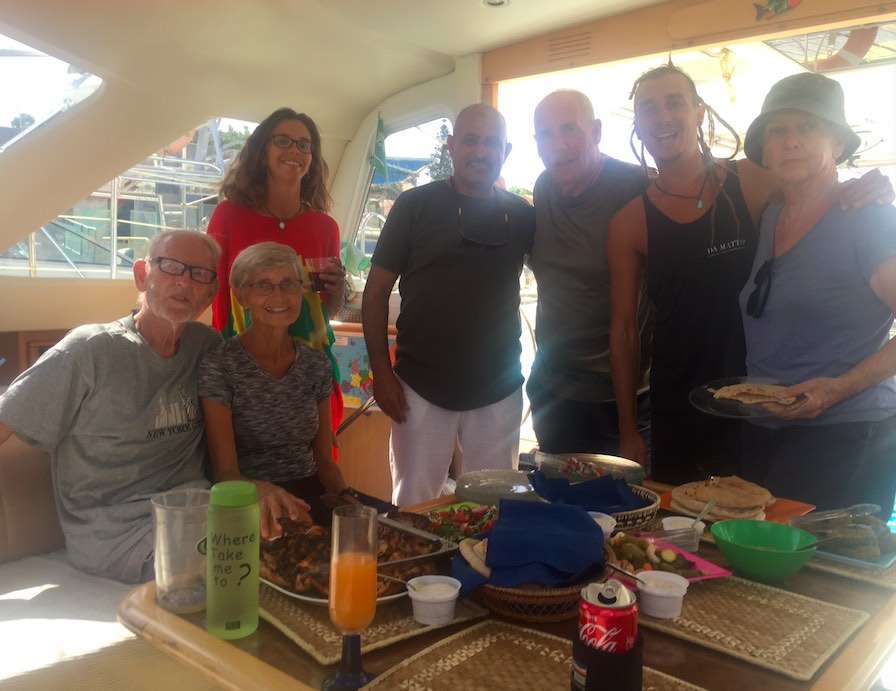
- The crew of SV Joana enjoying lunch with Capt. Heebie.
One of our cruising friends who is a Captain on the container ship Mersk Gibraltor actually took this photo of SV Joana transiting the canal, and emailed it to us a few hours later.

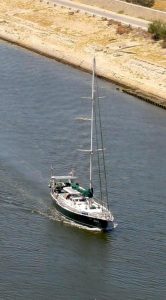
- SV Joana in the Suez Canal.
Made it to Turkey!
We arrived at Alanya Marina in Eastern Turkey on 29 June 2020. The staff are warm and welcoming. The marina is in very good condition, and the prices are quite good. We are actually paying less than we were in India, for first-world facilities and excellent repair shops.
Should anyone wish to read my blog, and see what our experiences were in much more detail, the site address is detailed below.
I expect to remain as an Administrator with the FB Group page Red Sea Passage for at least the coming year, and should anyone wish to join, please email me at wade@joana.ca
Wade Alarie
SV Joana
…………………………………………………………………………………………………………………………………..
Please Note:
Any queries concerning the FB Group Red Sea Passage should be sent to Wade at wade@joana.ca.
…………………………………………………………………………………………………………………………………..
Related Content
Update for Red Sea Passage and Cochin, India (October 2019)
Indian Ocean and Red Sea Passage: Helping cruisers exchange information
……………………………………………………………………………………………………………………………………….
Related Links
Red Sea Passage Facebook Group
http://www.alanyamarina.com.tr
……………………………………………………………………………………………………………………………………….
The opinions expressed in this article are the author’s own and do not reflect the view of Noonsite.com or World Cruising Club.
Related to following destinations: Canal, Cochin (Kochi), Eastern Med, Egypt, Eritrea, India, Red Sea (Egypt), Suez Canal, Turkey, Yemen
Related to the following Cruising Resources: Circumnavigation, Gulf of Aden / Indian Ocean / Red Sea, Piracy & Security, Red Sea, Routing

We were one of the boats just 2 weeks behind Wade. All the ports closed while we were at sea. Whilst this is an exception this year I recommend having enough food and fuel to do this trip completely on your own.
We spent several weeks at anchor behind exposed reefs waiting for more moderate N winds. Our standard sailing configuration was a deeply furled jib and 2 reefs in the main with wind on the nose. Often we had 3 reefs and twice storm sails.
Don’t underestimate the stress and strain of beating to windward for 1500 miles. The reefa in the red sea are nor where ANY of the charts claim them to be. (we had 3 different sets of charts). The Indian ocean passage on the other hand was one of oir most pleasant Ocean passages…Mostly downwind in 10not 12 knots, relatively calm sea and lots of fish.
A note on water. Our water maker started breaking and eventualy failed altogether. We had enough water in the tanks to get us to Suez where we rook on more. Checking the log we had ZERO rainfall since Malaysia in December until we reached Crete in May…..6 months without any rain.
our blog is here – http://www.gbr195t.com/ – with details.